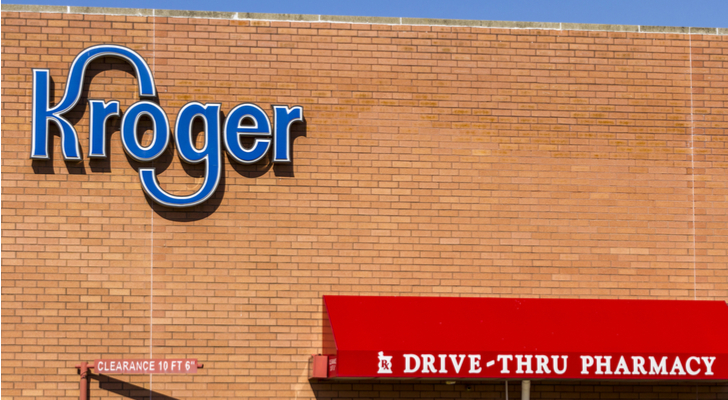I Googled some articles highlighting the best retail stocks to own in 2019; Kroger (NYSE:KR) and Kroger stock didn’t appear on a single list.
It’s easy to understand why Kroger stock is dicey for analysts — nine have it as a buy, 15 as a hold, and two as a sell — it’s getting its head handed to it by Amazon (NASDAQ:AMZN) and Walmart (NYSE:WMT); even Target (NYSE:TGT) is getting in on the action.
Grocery Is Very Competitive
In mid-December, Costco (NASDAQ:COST) shares took a hit, after the warehouse behemoth missed first-quarter earnings estimates .
“There’s been a little bit more retail competitive pressure out there, not only from supermarkets but Sam’s as well,” CFO Richard Galant said during the quarterly conference call Dec. 13. “We’ve got good fresh sales numbers, but we — like others — our competitors are working in a little lower margin.”
Don’t sweat it if you own Costco stock. Very few retailers are as good as it is at adapting to market pressures. It will be fine.
Over at Walmart and Target, both companies (note Galant’s comment above about Sam’s, a Walmart banner) are doing a good job grabbing grocery market share.
Target’s in the middle of transforming its grocery operations. In 2018, Target hired a couple of grocery executives to improve its food and beverage offerings in its stores. Also, it continues to grow private label grocery brands such as Archer Farms, to better compete with Walmart and Amazon.
Target’s looking strong heading into 2019.
Walmart’s also making significant strides in the grocery game, something I alluded to in an August article about the company, noting that it had grocery pickup in more than 1,800 of its U.S. stores, a sign that part of its business is alive and well.
And then there’s Amazon.
Some experts believe Amazon’s got a long way to go if it wants to satisfy the overall needs of grocery shoppers beyond delivering essentials or hard-to-find items.
While the statistics don’t lie — grocery shoppers spend an average of $200 a month with grocery delivery services such as Instacart compared to $74 per month at Amazon — Amazon’s combination of Prime with Whole Foods is bound to bear fruit in the years ahead.
Don’t you worry, Jeff Bezos and company will figure out how to leverage the two brands to grow grocery revenues.
Kroger Stock and the Delivery Market
There’s no doubt that Kroger’s faced an uphill battle against some of these non-traditional grocery providers. That said, it didn’t sit still in 2018.
For example, Kroger has launched a grocery delivery service in Arizona that uses unmanned vehicles to deliver online orders to customers’ homes through a partnership with Nuro, a Silicon Valley autonomous driving startup.
The service costs $5.95 plus the order itself. There’s no minimum order. Nuro’s fleet of self-driving, unmanned vehicles, will provide same-day or next-day delivery.
“Nuro envisions a world without errands, where everything is on-demand and can be delivered affordably,” Nuro President and co-founder Dave Ferguson said in the joint press release. “Operating a delivery service using our custom unmanned vehicles is an important first step toward that goal.”
What began in August as a self-driving Prius fleet with a person in the car for safety purposes completing more than one thousand deliveries has morphed into an unmanned service that should help continue to grow Kroger’s digital sales.
However, that’s not the only thing Kroger’s been doing to fend off the competition.
It’s also been renovating stores to make them more technologically efficient for both customers and employees, sending groceries through the mail, more private label brands and products, rolled out the company’s meal kit Home Chef across the country, and many more.
The Bottom Line on Kroger Stock
The big fly in the ointment for Kroger shareholders is the company’s profitability, which has taken a hit given the investments it’s made on the digital side of its business.
That’s likely a temporary situation. Once some of the initiatives it was working on in 2018 are fully implemented along with future efforts like rolling out the unmanned delivery service, I’d expect operating profits to revisit the 3% range.
Trading at 12 times its forward P/E and yielding close to 2%, 2019 — assuming the economy stays strong and the markets don’t correct too much further — could be the year Kroger stock revisits $40, something it hasn’t done since 2015.
As of this writing Will Ashworth did not hold a position in any of the aforementioned securities.

